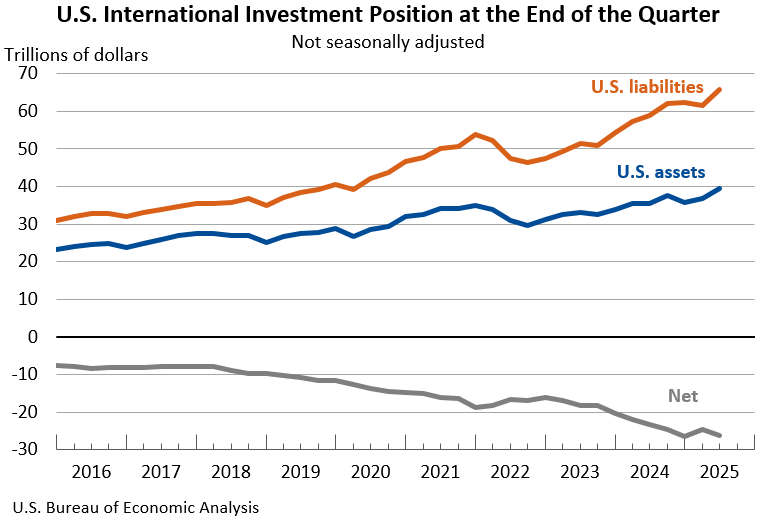Notice
Due to a lapse in appropriations, this website is not being updated.
Bureau of Economic Analysis
U.S. International Investment Position, 2nd Quarter 2025
The U.S. net international investment position, the difference between U.S. residents’ foreign financial assets and liabilities, was -$26.14 trillion at the end of the second quarter of 2025, according to statistics released today by the U.S. Bureau of Economic Analysis. Assets totaled $39.56 trillion, and liabilities were $65.71 trillion. At the end of the first quarter, the net investment position was -$24.65 trillion (revised).
Principal Federal Economic Indicators
Noteworthy
The Latest
Gross Domestic Product for Guam, 2018
The estimates of GDP for Guam show that real GDP—GDP adjusted to remove price changes—decreased 0.3 percent in 2018 after increasing 0.2 percent in 2017. For comparison, real GDP for the United States (excluding the territories) increased 2.9 percent in 2018 after increasing 2.4 percent in 2017.
U.S. International Trade in Goods and Services, August 2019
The U.S. monthly international trade deficit increased in August 2019 according to the U.S. Bureau of Economic Analysis and the U.S. Census Bureau. The deficit increased from $54.0 billion in July (revised) to $54.9 billion in August, as imports increased more than exports. The previously published July deficit was $54.0 billion. The goods deficit increased $0.8 billion in August to $74.4 billion. The services surplus decreased less than $0.1…
August 2019 Trade Gap is $54.9 Billion
The U.S. monthly international trade deficit increased in August 2019 according to the U.S. Bureau of Economic Analysis and the U.S. Census Bureau. The deficit increased from $54.0 billion in July (revised) to $54.9 billion in August, as imports increased more than exports. The previously published July deficit was $54.0 billion. The goods deficit increased $0.8 billion in August to $74.4 billion. The services…
Personal Consumption Expenditures by State, 2018
State personal consumption expenditures (PCE) increased 5.1 percent in 2018, an acceleration from the 4.4 percent increase in 2017. The percent change in PCE across all states ranged from 7.3 percent in Utah to 3.6 percent in West Virginia.
Personal Consumption Expenditures by State, 2018
State personal consumption expenditures (PCE) increased 5.1 percent in 2018, an acceleration from the 4.4 percent increase in 2017. The percent change in PCE across all states ranged from 7.3 percent in Utah to 3.6 percent in West Virginia.
U.S. International Investment Position Second Quarter 2019
The U.S. net international investment position, the difference between U.S. residents’ foreign financial assets and liabilities, was –$10.56 trillion at the end of the second quarter of 2019, according to statistics released by the U.S. Bureau of Economic Analysis (BEA). Assets totaled $28.01 trillion and liabilities were $38.56 trillion. At the end of the first quarter, the net investment position was –$10.16 trillion.
U.S. International Investment Position, Second Quarter 2019
The U.S. net international investment position, the difference between U.S. residents’ foreign financial assets and liabilities, was –$10.56 trillion at the end of the second quarter of 2019, according to statistics released by the U.S. Bureau of Economic Analysis (BEA). Assets totaled $28.01 trillion and liabilities were $38.56 trillion. At the end of the first quarter, the net investment position was –$10.16 trillion.
Real Disposable Personal Income Rises in August
Personal income increased 0.4 percent in August after increasing 0.1 percent in July. Wages and salaries, the largest component of personal income, increased 0.6 percent in August after increasing 0.2 percent in July.
Personal Income and Outlays, August 2019
Personal income increased 0.4 percent in August after increasing 0.1 percent in July. Wages and salaries, the largest component of personal income, increased 0.6 percent in August after increasing 0.2 percent in July.
GDP Increases in Second Quarter
Real gross domestic product (GDP) increased 2.0 percent in the second quarter of 2019, according to the “third” estimate released by the Bureau of Economic Analysis. The growth rate was the same as in the “second” estimate released in August. In the first quarter, real GDP rose 3.1 percent.




